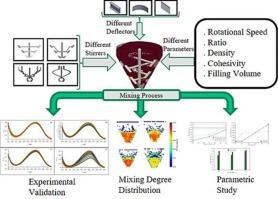通过 DEM 设计和优化搅拌器和混合器设计,以正确混合药粉
IF 4.5
2区 工程技术
Q2 ENGINEERING, CHEMICAL
引用次数: 0
摘要
颗粒材料的混合是制药业的一个重要过程。本研究提出了一种可量化的计算方法来确定混合物的最终混合度。在此基础上,研究了搅拌器设计、转速、粉末密度、凝聚力、材料比率以及通过不同设计的导流板引导的颗粒在腔体内的运动对最终混合质量的影响。结果表明,提高搅拌速度可以提高混合质量。然而,对于相对密度较高的二元混合物,采用不同的转速模式可提高混合度。随着接触叶片数量的增加,混合效果也会有所改善。最后,简易导流板的引入极大地提高了混合质量,并使进料成为可能,这对于粘性粉末的连续操作至关重要,通过使用更多的混合体积,使过程更加稳定和高效。本文章由计算机程序翻译,如有差异,请以英文原文为准。

Design and optimization of stirrer and mixer design for the correct mixing of pharmaceutical powders through DEM
Mixing of granular materials is an important process for pharmaceutical industries. In this study, a quantifiable calculation method was suggested to determine the final mixing degree of the mixture. Based on that, the effect of the stirrer design, rotational speed, powder density, cohesivity, material ratios, and particle movement in the chamber guided through different designs of deflectors on the final mixing quality is examined. The results show that increasing the stirring speed, generates better mixing quality. However, introducing a varying rotational speed mode improves the mixing degree specially for binary mixtures with high relative densities. The improvement of the mixing with the number of contacting blades is observed. Finally, the introduction of a simple deflector drastically enhances the mixing quality and enables the feeding into the chamber, which is key for continuous operation with cohesive powders, making the process more stable and efficient by using more of the mixing volume.
求助全文
通过发布文献求助,成功后即可免费获取论文全文。
去求助
来源期刊

Powder Technology
工程技术-工程:化工
CiteScore
9.90
自引率
15.40%
发文量
1047
审稿时长
46 days
期刊介绍:
Powder Technology is an International Journal on the Science and Technology of Wet and Dry Particulate Systems. Powder Technology publishes papers on all aspects of the formation of particles and their characterisation and on the study of systems containing particulate solids. No limitation is imposed on the size of the particles, which may range from nanometre scale, as in pigments or aerosols, to that of mined or quarried materials. The following list of topics is not intended to be comprehensive, but rather to indicate typical subjects which fall within the scope of the journal's interests:
Formation and synthesis of particles by precipitation and other methods.
Modification of particles by agglomeration, coating, comminution and attrition.
Characterisation of the size, shape, surface area, pore structure and strength of particles and agglomerates (including the origins and effects of inter particle forces).
Packing, failure, flow and permeability of assemblies of particles.
Particle-particle interactions and suspension rheology.
Handling and processing operations such as slurry flow, fluidization, pneumatic conveying.
Interactions between particles and their environment, including delivery of particulate products to the body.
Applications of particle technology in production of pharmaceuticals, chemicals, foods, pigments, structural, and functional materials and in environmental and energy related matters.
For materials-oriented contributions we are looking for articles revealing the effect of particle/powder characteristics (size, morphology and composition, in that order) on material performance or functionality and, ideally, comparison to any industrial standard.
 求助内容:
求助内容: 应助结果提醒方式:
应助结果提醒方式:


